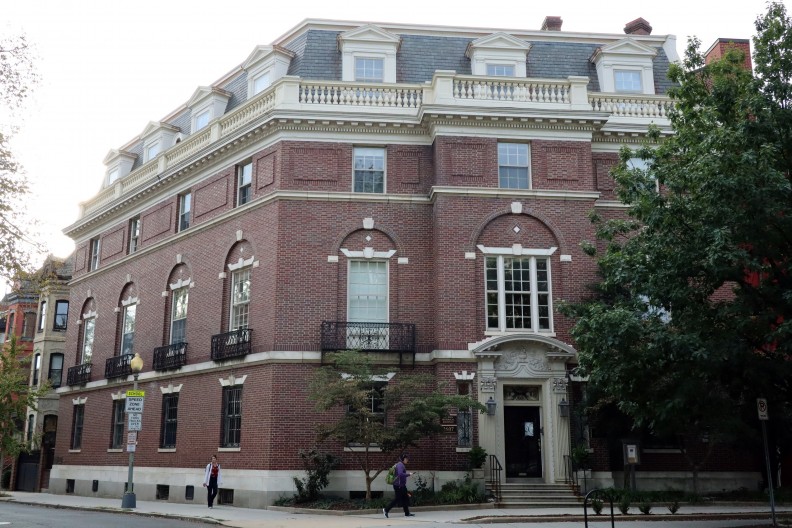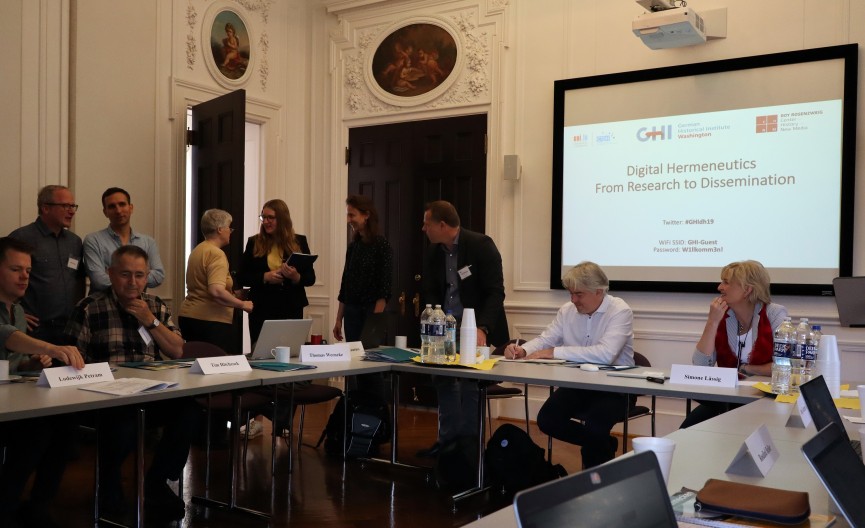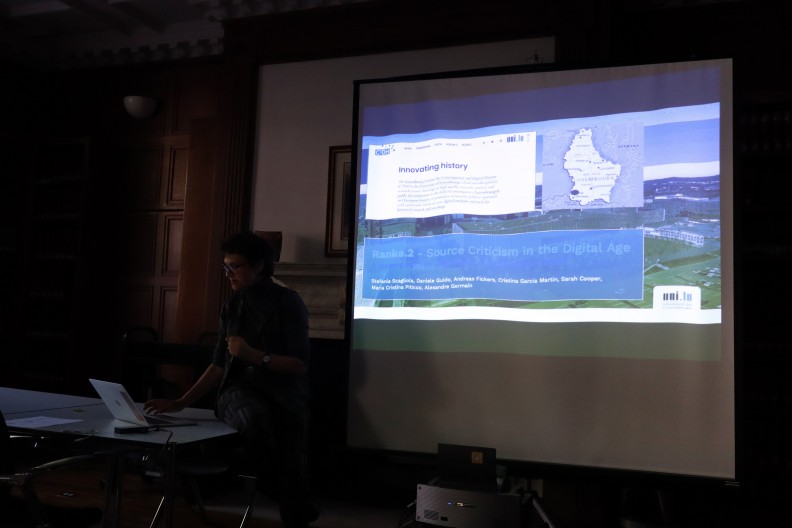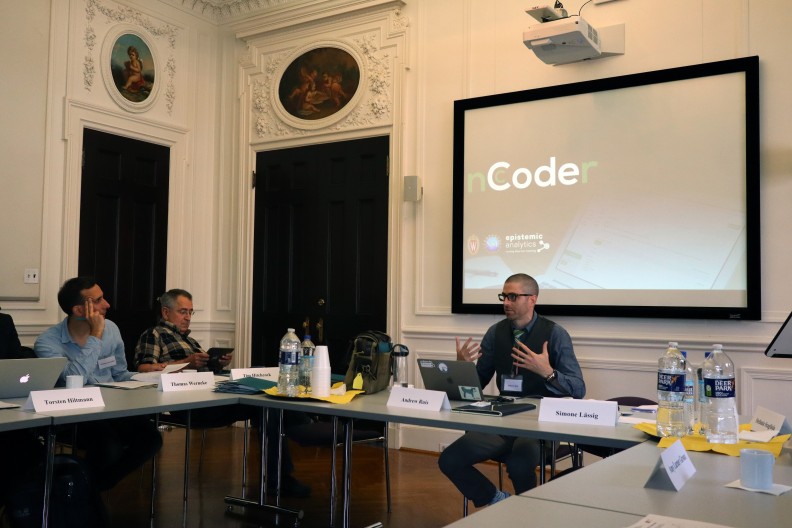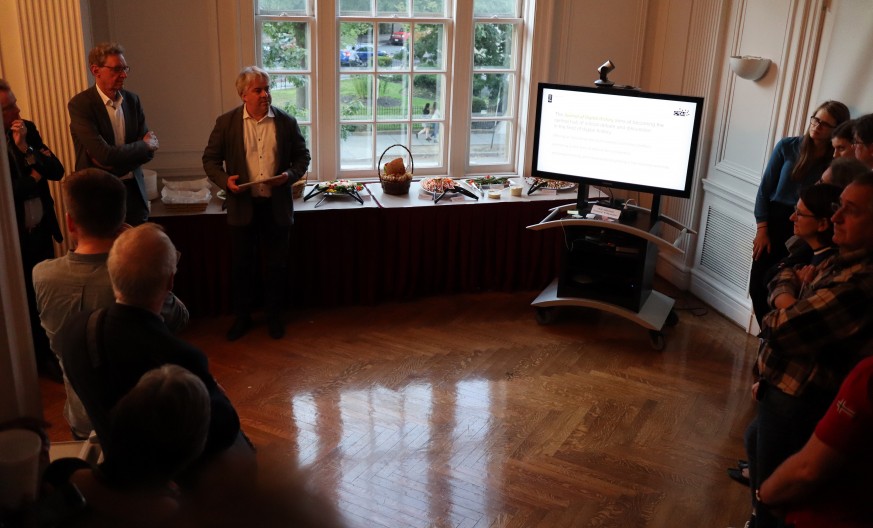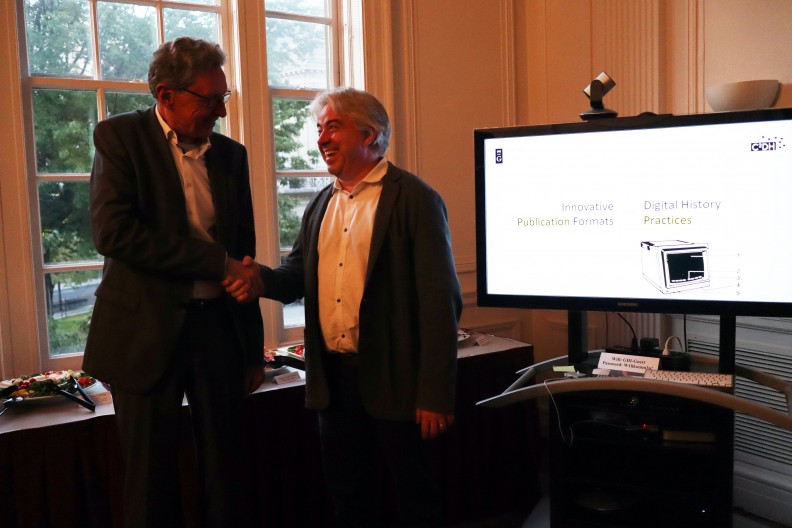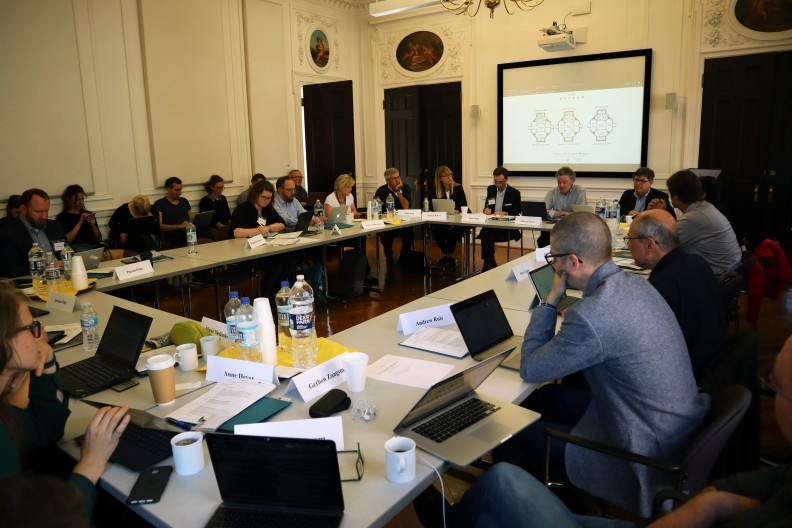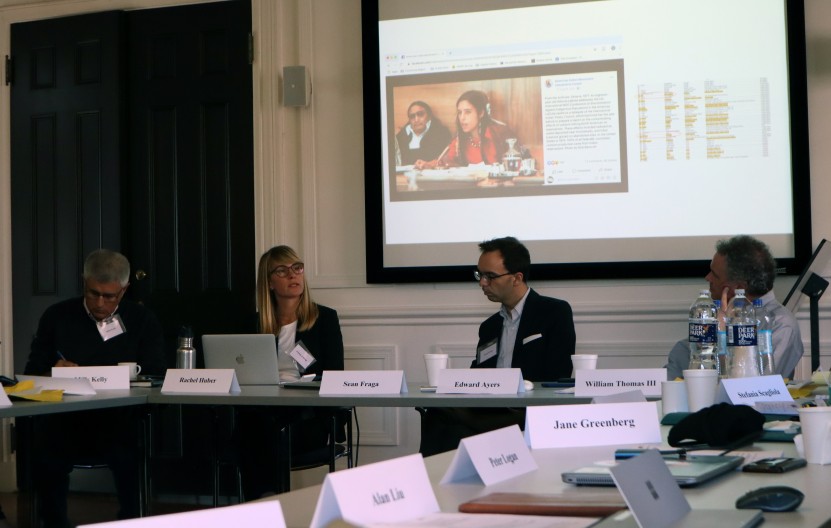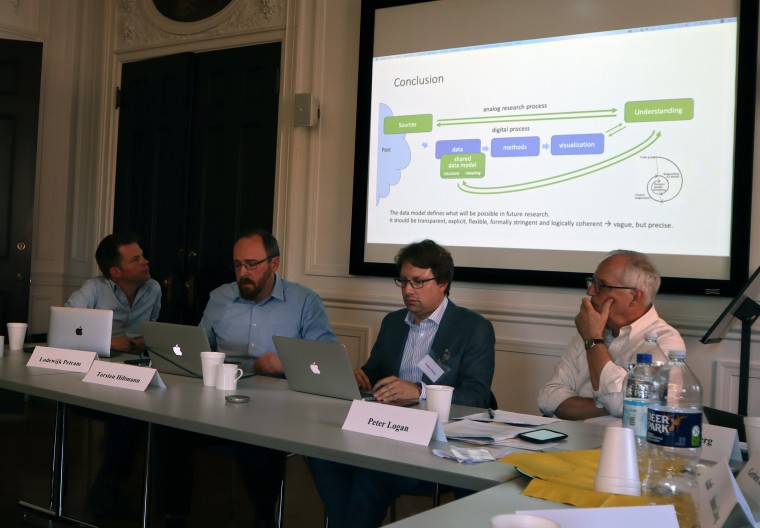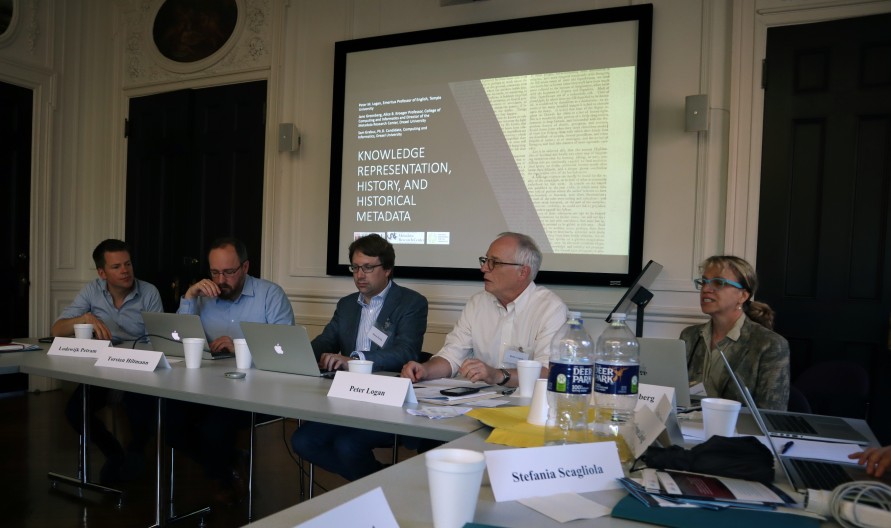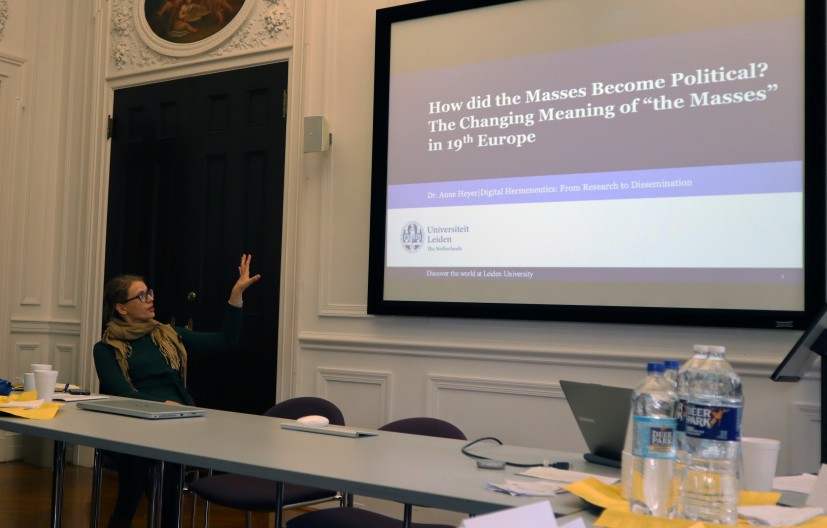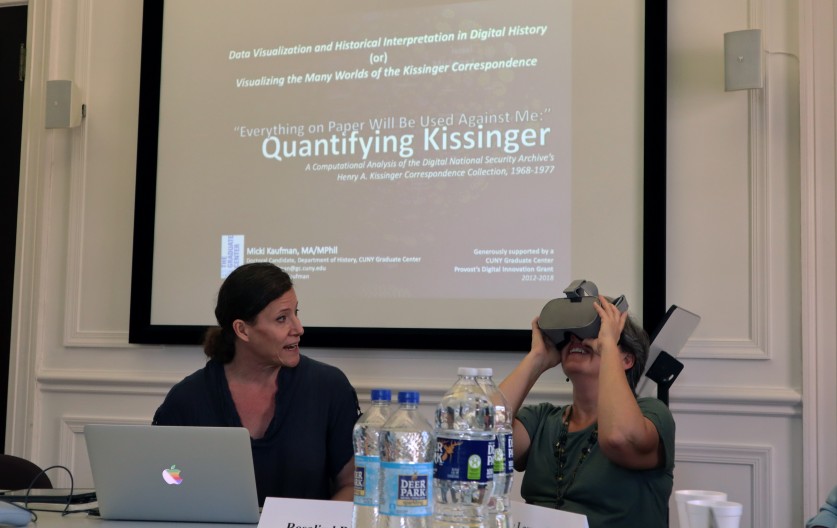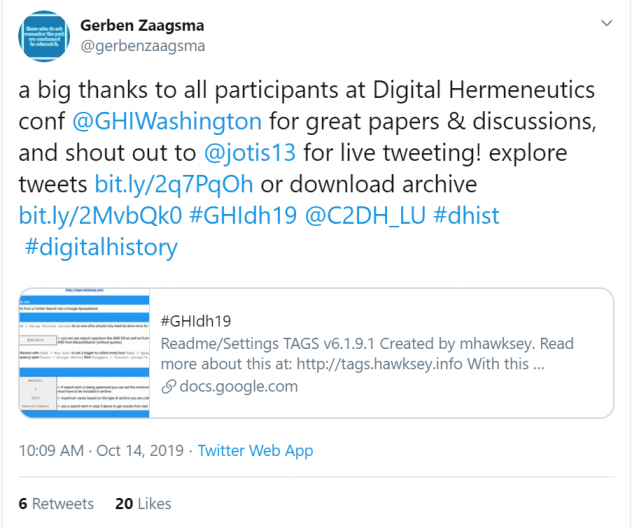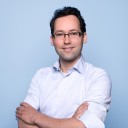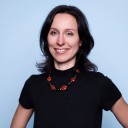The ‘Digital Hermeneutics: from Research to Dissemination’ conference was the 4th Annual GHI Conference on Digital Humanities and Digital History and was co-organized by the C²DH and the Roy Rosenzweig Center for History and New Media. The theme of ‘digital hermeneutics’ marks a “pivotal question” according to GHI director Simone Lässig. In her welcome word to the conference participants, she argued that as historians we need to rethink our work in the wake of the digital turn. Central to the philosophy of the C²DH as well, the hermeneutic approach constitutes a “reflexive” wave in digital humanities according to Andreas Fickers. The conference provided an opportunity to engage in a transatlantic dialogue on this critical issue in our field.
Workshops
We started the first conference day with four hands-on workshops. The first workshop addressed the theme of Digital Hermeneutics in Education. It included presentations, demonstrations and hands-on exercises organized by Stefania Scagliola (C²DH) on how to integrate elements of the Ranke 2.0 teaching platform for digital source criticism in humanities curriculum, and by Frederick W. Gibbs (University of New Mexico) who reflected on strategies for enabling students to create and contribute to digital community-based history projects. Both speakers discussed the practical challenges such projects inevitably bring, but also emphasized the possibilities of digital platforms and tools to promote active learning and engagement with history. For instance, by means of an interactive quiz or through the co-creation of GitHub-based webpages for disseminating local history.
The second workshop was organized by Maret Nieländer (Georg Eckert Institute for International Textbook Research, Braunschweig) and Thomas Werneke (Humboldt-Universitat, Berlin). While Nieländer explored the use of the text mining tool DiaCollo for performing collocation analysis of historical text corpora, Werneke discussed various ways of doing text mining and distant reading with regard to the field of historical semantics. Katharina Hering (GHI) showed in the third workshop on ‘Digital Resource Criticism’ how to develop and read a multidisciplinary Zotero Group Bibliography. The problems following the division of infrastructure between academia and archives were discussed and conditions on both sides of the Atlantic were compared during the workshop. Finally, in the fourth workshop, Andrew R. Ruis (University of Wisconsin-Madison) demonstrated how to use the nCoder as a new tool for merging close reading methods with computational text analysis.
Connecting the “micro” and the “macro”
In the late afternoon, the program continued with a round table discussion by Rosalind Beiler and Amy Larner Giroux (University of Central Florida), Katherine Faull and Diane Jakacki (Bucknell University) and Ursula Lehmkuhl (Trier University) on the theme of “mobile lives – digital approaches to a world in motion”. The round table discussed how digital tools for text mining and network visualization allow for identifying patterns and changes over time in large textual collections on transatlantic, mainly religiously motivated movements, such as historical family letters. On the basis of their research projects1, the panellists highlighted how this allows for aggregating stories of everyday life that connect the “micro” to the “macro” levels (and vice versa) and for visualizing mobile lives trends beyond the illustrative and exemplary. Something that would not have been possible with traditional methods of text analysis, interpretation and presentation, as they argued.
Launch of "Journal for Digital History"
In the evening, the new open access “Journal for Digital History” was officially launched, a collaboration between the C²DH in Luxembourg and De Gruyter Publishers. The journal will be equipped with a total of three full positions on both sides and aims to become an innovative platform for publishing digital history research. The journal will introduce new levels of dissemination formats that will provide different angles on a single research topic, ranging from a traditional paper to visualisations of interactive data sets. The first issue is forthcoming in 2021/2022.
- 1. Giroux and Beiler discussed their project People, Religion, Information, Networks, and Travel (PRINT): The Dynamics of Migration in the Early Modern World. Faull and Jakacki showcased Moravian Lives - Tracing the Movements and History of Members of the Moravian Church (1750-2012). Lehmkuhl talked about Auswandererbriefe aus Nord-Amerika (letter from German immigrants in the US sent back home) and the recently started German Heritage in Letters (letters from those who stayed behind to their migrated family members in the US).
Digital source criticism
The second conference day – Friday 11 October – started with a panel on Digital Source Criticism. C²DH members Tim van der Heijden and Juliane Tatarinov shared their experiences on the Doctoral Training Unit (DTU) “Digital History and Hermeneutics”, a four-year interdisciplinary research and training project funded by the Luxembourg National Research Fund (FNR). By conceptualizing the DTU as a “trading zone” in digital history, they reflected on the project’s first year, its training programme and the project’s website as an interactive platform for doing digital hermeneutics in an interdisciplinary setting. Pascal Föhr (State Archive of Solothurn) and Christian Keitel (Landesarchiv Baden-Württemberg / Potsdam University of Applied Sciences) followed with presentations respectively on historical source criticism in the digital age, and the opportunities and constraints on the use of digital-born sources from an archivist’s perspective. Their presentations also underscored the need for professional historians to engage more with the experience of digital archivists and librarians who are at the forefront of the digital turn in heritage work.
The discussion at the end of the panel touched on a wide variety of issues. For instance, how does the digital turn affect the relationship between historians and archivists? Are private institutions a valid alternative? What does it mean when historians are becoming producers of their own digital archives? How to validate the integrity of a digital source or object? To what degree is digital history becoming a new discipline in its own right, or should we consider the digital to be an extension to the traditional historical discipline?
What does “the D” do?
The question what the Digital (“the D”) does – and subsequently the question of what “the H” (history/humanities) does – was a recurring topic throughout the conference. One preliminary observation was that “the D” brings the Humanities back in contact again with each other and even Social Sciences and Sciences become part of the dialogue.
After a short panel on digital history funding on both sides of the Atlantic, the topic became especially significant in the panel on Digital and Transmedia Storytelling, which included presentations by digital history pioneers Edward L. Ayers (University of Richmond) and William G. Thomas III (University of Nebraska-Lincoln). Ayers and Thomas reflected on their collaborative work in the digital public history project “Beyond the Valley of the Shadow”, and discussed the possibilities of digital storytelling for historical narration in relation to some of their current research projects: Mapping Inequality (by the Digital Scholarship Lab) and a reconstruction of an early 19th century enslaved woman, named Anna Williams (http://annwilliamsfilm.com/).
The panel furthermore included an impressive presentation by Rachel Huber (University of Lucerne), on the question of how digital history can make the narratives of suppressed minorities visible (in this case female activists of the Red Power movement). Huber provided a powerful example of how retrodigitised ‘traditional’ sources can be combined with born-digital sources, such as various social media, to bring indigenous perspectives into focus and excavate the previously untold. Finally, Sean Fraga (Princeton University) presented his views on how to narrate a non-narrative source with digital humanities tools.
Modelling the Analogue
The third and final panel of the day, entitled “modelling the analogue”, touched upon the epistemological implications of the shift from analogue to digital research methodologies. How can we produce new historical knowledge when modelling or transforming analogue sources and collections into digital datasets for computational analysis and visualization? Torsten Hiltmann (University of Münster) presented some reflections on the consequences of data modelling for digital hermeneutics. Comparing analogue to digital methods for knowledge production, he argued that the ‘analogue’ hermeneutic cycle is fundamentally different to the digital research process. While in the analogue realm one can always go back to the sources and re-read or re-interpret them, in the digital process you can often only go back to the data, and the data models we use determine the information from the sources we have at our disposal, and thus the questions we can ask. Hiltmann consequently advocated for a digital hermeneutics, which makes transparent and explicit the conceptual work done in data modelling.
Lodewijk Petram and Sebastiaan Derks (Huygens Institute for the History of the Netherlands) made a similar argument based on a case study on different usages of a specific “fuzzy and complex” historical data collection containing information about careers of sailors of the Dutch East Indie Company. The complexity of historical datasets – and the data curation effort which is required to make them usable for analysis – is often overlooked by digital historians and seldomly explicated in their publications, which is problematic. Peter Logan (Temple University) and Jane Greenberg (Drexel University) presented how they worked with historical controlled vocabularies (HIVE) for mapping the history of knowledge in their Nineteenth-Century Knowledge Project. Finally, Simon Donig (University of Passau) reflected in his presentation on the use of artificial intelligence for the historical disciplines and the epistemological challenges of machine learning he faced in his Neoclassica research project.
Textual and visual hermeneutics
Two more panels were held on the third and final conference day, Saturday 12 October. The first panel, entitled The Challenge of the Collection, started with a presentation by Sarah Oberbichler (University of Innsbruck), who discussed the ways in which she and her colleague Barbara Klaus used digital historical newspapers to study return migration to Europe (1850-1950) in their NewsEye project, and the interface challenges they ran into and how these shaped the research. Among others, she emphasized the importance of metadata and full transparency about OCR quality of digitized text corpora for working with such interfaces. Anne Heyer (Leiden University) presented her research within the framework of the EU Horizon 2020-funded TRANSPOP project (Juan March Institute, Universidad Carlos III Madrid) on the changing meaning of “the masses” in nineteenth-century Europe from a transnational perspective, also using digitised newspaper corpora. Achim Saupe (Leibniz Centre for Contemporary History Potsdam) reflected on the possibilities and limitations of DiaCollo as a digital tool for “blended reading” (combining distant and close reading) and analysing semantic changes in the GDR press corpus.
The second panel discussed the topic of Visual Hermeneutics: how to use digital tools for the visualization of historical accounts and (audio-visual) presentation of historical analyses? Micki Kaufman (The Graduate Center, CUNY) presented her PhD research project “Quantifying Kissinger”, which deploys the possibilities of virtual reality tools for the analysis, visualization and historical interpretation of the Digital National Security Archive’s Henry A. Kissinger correspondence. Kaufman argued that VR allows for new forms of engaging with the archive and navigating historical sources in more direct, spatial and playful ways. Silke Schwandt (University of Bielefeld), who reflected in her presentation on the question how productive digital tools are for historians, likewise emphasized the potential of visualization for historical analysis, interpretation and dissemination. Coming back to the question of what “the D” does in historical research practice, she argued that digital technologies allow for new ways of interacting with the source material, new forms of storytelling and accessibility, and as such can provide new perspectives on the historical subject (i.e. zooming in and out, navigating through time and space). This potential was also illustrated in the final presentation by Rosalind Beiler and Amy Giroux (University of Central Florida), who focused on the affordances of Gephi for the interactive and dynamic visualization of complex early modern communication networks.
“Productive irritation” for sensing the past in new ways
The concluding discussion – a dialogue between Alan Liu (University of California, Santa Barbara), Tim Hitchcock (University of Sussex) and Jessica Otis (Roy Rosenzweig Center for History and New Media), moderated by Simone Lässig (GHI, moderator) – took Liu’s recent book Friending the Past: The Sense of History in the Digital Age, as its point of departure in a wide-ranging debate.
The ensuing discussion highlighted that the digital, besides offering new possibilities for historical research, also comes with new challenges, or something Schwandt called “productive irritation”. Andreas Fickers subsequently argued that it is exactly this productive irritation or “creative uncertainty” where we should start our investigation as digital historians. Instead of reproducing certainties, digital tools and methods should help us to explore, visualize, interpret and sense the past in new ways.
The concluding discussion turned back to several crucial points that define the digital turn in historical research. Digital methods can, for instance, accommodate the complex structure of time that cannot be depicted as simply linear or neatly layered. On the other hand they pose challenges with regard to the transition from ‘traditional’ sources that are heterogeneous, incomplete, complex and imperfect to “cleaned up” ‘data’ with different scales and materialities. New digital and visual literacies amongst scholars might also bring challenges in the relationship between senior and junior scholars as Simone Lässig reminded us. And as Fredd Gibbs pointed out in one of the last remarks of the conference, the added value of the ‘digital’ should not only be investigated within the field. Digital Public History projects create new links with industry or cultural heritage partners and create new visibilities for old historical questions. By creating new narrative forms, history as a discipline is being opened up to new audiences and might acquire a new reputation in the public sphere.
Further reading / more information
For more information about the conference program, see: https://www.ghi-dc.org/events-conferences/event-history/2019/conferences/2019-dh-conf.html?L=0.1 You can also explore the conference tweets or download the archive via: https://twitter.com/gerbenzaagsma/status/1183656119404826624.
- 1. The authors would like to thank all participants and the organizers of the conference "Digital Hermeneutics: from Research to Dissemination", in particular Simone Lässig, Jens Pohlmann and Daniel Burckhardt from the German Historical Institute, Washington DC.



